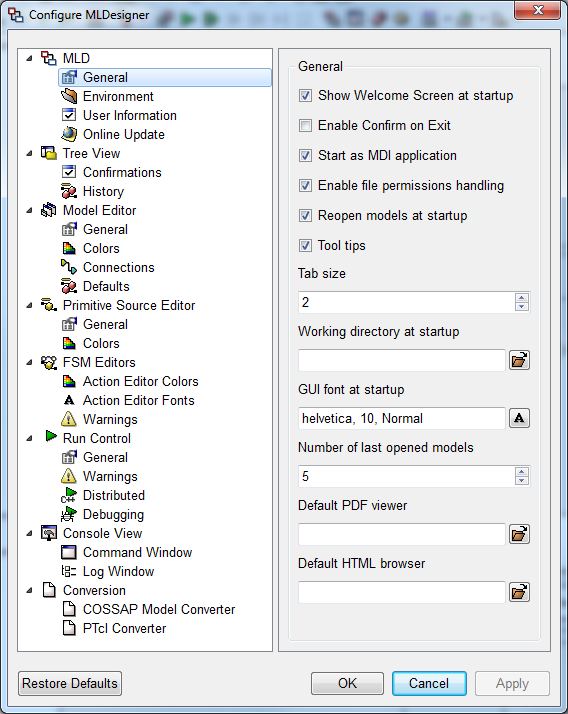
- General
- Show Welcome Screen at startup
Shows the Welcome Screen at startup. The Welcome screen can also be invoked via Help Menu→Welcome
- Enable Confirm on Exit
When enabled you will be asked for confirmation when exiting MLDesigner
- Start as MDI application
The graphical user interface is a Multi-Document Interface (MDI) when this option is checked. In non-MDI modus each window is opened as a separate entity and can be handled separately making window management a lot more flexible.
- Enable File permissions handling
Specifies whether MLDesigner should deal with file permissions of model directories and files or if it is left to the operating system. In later case GUI elements are disabled and you have to use system commands to deal with file permissions.
- Reopen models at startup
All open models will be reopened when MLDesigner is shut down and restarted.
- Tool tips
Turns all tooltip texts off when the tick is removed from this checkbox.
- Tab size
The tab size for all text editors.
- Working directory at startup
The default path of the command console is set with this variable. This setting becomes effective after shutting down and restarting MLDesigner.
- GUI font at startup
The font for all graphical user interface elements. You must shut down and restart MLDesigner before the setting takes effect.
- Number of last opened models
Specifies the maximum number of models in the list of last opened models.
- Default PDF viewer
Specifies the PDF document browser. If left empty the operating system's default PDF viewer will be used.
- Default HTML browser
Specifies the HTML browser used to open websites. If left empty the operating system's default HTML browser will be used.
- Show Welcome Screen at startup
- User Information
- Name
The default author notice for user defined model elements. Appears in the tooltip text for primitives, in the online documentation and in primitive source code for primitives, modules and systems. - Organization
The default company information for future use.
- Copyright
The default copyright notice for user defined model elements. Appears in the tooltip text for primitives, in the online documentation and in primitive source code for primitives, modules and systems.
- Name
- Environment
- $MLD_USER
The model base My Libraries points to the physical directory registered in this field. Changes to this setting are only valid for the current modeling session.
- $MLD_SHARED
The model base Shared Libraries points to the physical directory registered in this field. Changes to this setting are only valid for the current modeling session.
- $MLD_TEMP
Specifies the folder where the temporary files produced by MLDesigner are stored.
- $MLD_USER
-
Online Update
- Enable
Specifies whether a notification appears if an update is available.
- MLDesigner Update Server URL
Specifies the URL of the MLDesigner Update Server. Is set by default.
- Check for Updates every x days
Specifies how often MLDesigner will check for updates.
- Enable